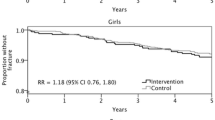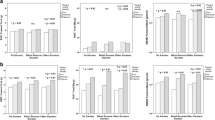Abstract
Summary
This is the first study indicating an association between gradually diminished risk of fractures and years of increased physical activity. Our results could imply great benefits not only for the individual but also for the healthcare burden and cost of society.
Introduction
Physical activity (PA) in childhood is associated with high bone mass and beneficial neuromuscular function. We investigate if increased PA also is associated with fracture risk.
Methods
We registered fractures in 3534 children aged 6 to 8 years at study start for up to 7 years; 1339 with 40 min of moderate PA every school day (intervention) and 2195 with the Swedish standard curriculum of 60 min of PA per school week (controls). In a subsample of 264 children, we measured areal bone mineral density (aBMD; g/cm2) with dual-energy X-ray absorptiometry (femoral neck and total spine) and muscle strength (peak torque for knee extension and flexion; Nm) with computerized dynamometer at baseline and after 7 years. We estimated annual fracture incidence rate ratios (IRR) in the intervention group compared to the control group as well as changes in bone mass and muscle strength. Data is given as mean (95 % CI).
Results
The IRR of fractures decreased with each year of the PA intervention (r = −0.79; p = 0.04). During the seventh year, IRR was almost halved [IRR 0.52 (0.27, 1.01)]. The intervention group had a statistically significant greater gain in total spine aBMD with a mean group difference of 0.03 (0.00, 0.05) g/cm2 and peak flexion torque 180° with a mean group difference of 5.0 (1.5, 8.6) Nm.
Conclusions
Increased PA is associated with decreased fracture risk, probably in part due to beneficial gains in aBMD and muscle strength.

Similar content being viewed by others
References
Abrahamsen B, van Staa T, Ariely R, Olson M, Cooper C (2009) Excess mortality following hip fracture: a systematic epidemiological review. Osteoporos Int 20(10):1633–1650. doi:10.1007/s00198-009-0920-3
Johnell O, Kanis JA (2006) An estimate of the worldwide prevalence and disability associated with osteoporotic fractures. Osteoporos Int 17(12):1726–1733. doi:10.1007/s00198-006-0172-4
Borgstrom F, Zethraeus N, Johnell O, Lidgren L, Ponzer S, Svensson O, Abdon P, Ornstein E, Lunsjo K, Thorngren KG, Sernbo I, Rehnberg C, Jonsson B (2006) Costs and quality of life associated with osteoporosis-related fractures in Sweden. Osteoporos Int 17(5):637–650. doi:10.1007/s00198-005-0015-8
Nathorst Westfelt JA (1982) Environmental factors in childhood accidents. A prospective study in Goteborg, Sweden. Acta Paediatr Scand Suppl 291:1–75
Tiderius CJ, Landin L, Duppe H (1999) Decreasing incidence of fractures in children: an epidemiological analysis of 1,673 fractures in Malmo, Sweden, 1993–1994. Acta Orthop Scand 70(6):622–626
Landin LA (1983) Fracture patterns in children. Analysis of 8,682 fractures with special reference to incidence, etiology and secular changes in a Swedish urban population 1950–1979. Acta Orthop Scand Suppl 202:1–109
Spady DW, Saunders DL, Schopflocher DP, Svenson LW (2004) Patterns of injury in children: a population-based approach. Pediatrics 113(3 Pt 1):522–529
Hedstrom EM, Svensson O, Bergstrom U, Michno P (2010) Epidemiology of fractures in children and adolescents. Acta Orthop 81(1):148–153. doi:10.3109/17453671003628780
Chen JS, Sambrook PN (2012) Antiresorptive therapies for osteoporosis: a clinical overview. Nat Rev Endocrinol 8(2):81–91. doi:10.1038/nrendo.2011.146
Reiner M, Niermann C, Jekauc D, Woll A (2013) Long-term health benefits of physical activity—a systematic review of longitudinal studies. BMC Public Health 13:813. doi:10.1186/1471-2458-13-813
Karlsson MK, Nordqvist A, Karlsson C (2008) Physical activity, muscle function, falls and fractures. Food Nutr Res 52 doi: 10.3402/fnr.v52i0.1920
Kujala UM, Kaprio J, Kannus P, Sarna S, Koskenvuo M (2000) Physical activity and osteoporotic hip fracture risk in men. Arch Intern Med 160(5):705–708
Gregg EW, Cauley JA, Seeley DG, Ensrud KE, Bauer DC (1998) Physical activity and osteoporotic fracture risk in older women. Study of Osteoporotic Fractures Research Group. Ann Intern Med 129(2):81–88
Bailey DA, McKay HA, Mirwald RL, Crocker PR, Faulkner RA (1999) A six-year longitudinal study of the relationship of physical activity to bone mineral accrual in growing children: the university of Saskatchewan bone mineral accrual study. J Bone Miner Res 14(10):1672–1679. doi:10.1359/jbmr.1999.14.10.1672
Faigenbaum AD, Westcott WL, Loud RL, Long C (1999) The effects of different resistance training protocols on muscular strength and endurance development in children. Pediatrics 104(1):e5
Lofgren B, Daly RM, Nilsson JA, Dencker M, Karlsson MK (2013) An increase in school-based physical education increases muscle strength in children. Med Sci Sports Exerc 45(5):997–1003. doi:10.1249/MSS.0b013e31827c0889
Detter F, Rosengren BE, Dencker M, Lorentzon M, Nilsson JA, Karlsson MK (2014) A 6-year exercise program improves skeletal traits without affecting fracture risk: a prospective controlled study in 2621 children. J Bone Miner Res 29(6):1325–1336. doi:10.1002/jbmr.2168
Tveit M, Rosengren BE, Nilsson JA, Ahlborg HG, Karlsson MK (2013) Bone mass following physical activity in young years: a mean 39-year prospective controlled study in men. Osteoporos Int 24(4):1389–1397. doi:10.1007/s00198-012-2081-z
Erlandson MC, Kontulainen SA, Chilibeck PD, Arnold CM, Faulkner RA, Baxter-Jones AD (2012) Higher premenarcheal bone mass in elite gymnasts is maintained into young adulthood after long-term retirement from sport: a 14-year follow-up. J Bone Miner Res 27(1):104–110. doi:10.1002/jbmr.514
Tveit M, Rosengren BE, Nyquist F, Nilsson JA, Karlsson MK (2013) Former male elite athletes have lower incidence of fragility fractures than expected. Med Sci Sports Exerc 45(3):405–410. doi:10.1249/MSS.0b013e318274fdf3
Clark EM, Ness AR, Tobias JH (2008) Vigorous physical activity increases fracture risk in children irrespective of bone mass: a prospective study of the independent risk factors for fractures in healthy children. J Bone Miner Res 23(7):1012–1022. doi:10.1359/jbmr.080303
Kannus P, Haapasalo H, Sankelo M, Sievanen H, Pasanen M, Heinonen A, Oja P, Vuori I (1995) Effect of starting age of physical activity on bone mass in the dominant arm of tennis and squash players. Ann Intern Med 123(1):27–31
Linden C, Ahlborg HG, Besjakov J, Gardsell P, Karlsson MK (2006) A school curriculum-based exercise program increases bone mineral accrual and bone size in prepubertal girls: two-year data from the pediatric osteoporosis prevention (POP) study. J Bone Miner Res 21(6):829–835. doi:10.1359/jbmr.060304
Jonsson B, Gardsell P, Johnell O, Redlund-Johnell I, Sernbo I (1994) Remembering fractures: fracture registration and proband recall in southern Sweden. J Epidemiol Community Health 48(5):489–490
Tveit M, Rosengren BE, Nilsson JA, Karlsson MK (2014) Exercise in youth: high bone mass, large bone size, and low fracture risk in old age. Scand J Med Sci Sports. doi:10.1111/sms.12305
Flynn J, Foley S, Jones G (2007) Can BMD assessed by DXA at age 8 predict fracture risk in boys and girls during puberty?: an eight-year prospective study. J Bone Miner Res 22(9):1463–1467. doi:10.1359/jbmr.070509
Clark EM, Tobias JH, Murray L, Boreham C (2011) Children with low muscle strength are at an increased risk of fracture with exposure to exercise. J Musculoskelet Nueronal Interact 11(2):196–202
Clark EM, Ness AR, Tobias JH (2008) Bone fragility contributes to the risk of fracture in children, even after moderate and severe trauma. J Bone Miner Res 23(2):173–179. doi:10.1359/jbmr.071010
Yau DT, Chung RC, Pang MY (2013) Knee muscle strength and visual acuity are the most important modifiable predictors of falls in patients after hip fracture surgery: a prospective study. Calcif Tissue Int 92(3):287–295. doi:10.1007/s00223-012-9681-7
Lord SR, Ward JA, Williams P, Strudwick M (1995) The effect of a 12-month exercise trial on balance, strength, and falls in older women: a randomized controlled trial. J Am Geriatr Soc 43(11):1198–1206
Melton LJ 3rd, Atkinson EJ, O’Fallon WM, Wahner HW, Riggs BL (1993) Long-term fracture prediction by bone mineral assessed at different skeletal sites. J Bone Miner Res 8(10):1227–1233. doi:10.1002/jbmr.5650081010
Goulding A, Grant AM, Williams SM (2005) Bone and body composition of children and adolescents with repeated forearm fractures. J Bone Miner Res 20(12):2090–2096. doi:10.1359/JBMR.050820
Gunter KB, Almstedt HC, Janz KF (2012) Physical activity in childhood may be the key to optimizing lifespan skeletal health. Exerc Sport Sci Rev 40(1):13–21. doi:10.1097/JES.0b013e318236e5ee
Hui SL, Slemenda CW, Johnston CC Jr (1990) The contribution of bone loss to postmenopausal osteoporosis. Osteoporos Int 1(1):30–34
Siris ES, Baim S, Nattiv A (2010) Primary care use of FRAX: absolute fracture risk assessment in postmenopausal women and older men. Postgrad Med 122(1):82–90. doi:10.3810/pgm.2010.01.2102
McNamara A, Gunter K (2012) The influence of participation in better bones and balance on skeletal health: evaluation of a community-based exercise program to reduce fall and fracture risk. Osteoporos Int 23(6):1813–1822. doi:10.1007/s00198-011-1816-6
Acknowledgments
Financial support was received from the Centre for Athletic Research, the Herman Järnhardt Foundation, Swedish society of medicine, Skåne Regional Foundations, and ALF Foundations.
Conflicts of interest
None.
Author information
Authors and Affiliations
Corresponding author
Additional information
J. Fritz and M. E. Cöster contributed equally to this work.
Rights and permissions
About this article
Cite this article
Fritz, J., Cöster, M.E., Nilsson, JÅ. et al. The associations of physical activity with fracture risk—a 7-year prospective controlled intervention study in 3534 children. Osteoporos Int 27, 915–922 (2016). https://doi.org/10.1007/s00198-015-3311-y
Received:
Accepted:
Published:
Issue Date:
DOI: https://doi.org/10.1007/s00198-015-3311-y




